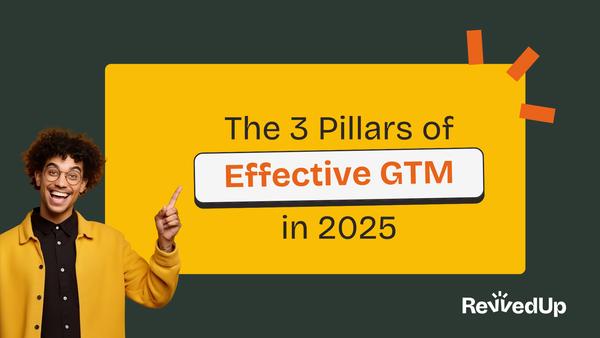The 3 Pillars of Effective GTM in 2025

Over the last few years, every business leader has had to navigate rapid macro shifts in their operating environment: Covid, rising interest rates, tariffs and economic uncertainty, the rapid rise of AI to name but a few.
This has had a profound impact on both buyers and sellers, fundamentally changing how they interact.
You’ve probably seen the symptoms.
It’s harder than ever to predictably build qualified pipeline; yet pressure to ‘do more with less’ has never been greater.
The question is: what’s driving these issues; and what can be done to overcome them?
Buyer Confusion and Risk Perception
First, let’s look at buyer behaviours and the go-to-market landscape to understand why pipeline generation is so difficult right now.
There are two major pressures impacting buyers right now: more choice than ever, and tightening budgets with rising expectations.
With the cost of shipping new products rapidly declining, thanks in part to the rise of vibe coding, and healthy early-stage capital markets, there is 10x more competition in just about every market category. And this will only continue.
This means buyers are inundated with potential solutions to their challenges, and its increasingly difficult for them to pick the winners and differentiate the signal from the noise.
At the same time, they know the wrong choice is going to be scrutinised. They’ll have mandates from the executive leadership to cut costs and increase productivity, and likely witnessed their colleagues depart thanks to RIFs.
Those two facts combined means any potential buyer has a higher sensitivity to risk.
And for those who’ve read Jolt, you’ll know that the risk of making the wrong decision often outweighs the risk of doing nothing, even when they’re aware of a problem that could be solved by an external solution.
So what are buyers doing?
Whenever faced with risky, potentially ‘dangerous’ situations, humans naturally seek out safe harbour.
There is a massive flight to trust taking place right now.
For buyers, this largely means they are increasingly relying on networks, brand and AI to help them make decisions.
At least to whittle down the overwhelming choice in the initial consideration phase of a buying cycle.
And then again at the end, to provide re-assurance they are going to make the right decision.
The concept of “Nobody got fired for buying IBM” is likely to be one of the core tenets for anyone bringing in new solutions…they’ll choose brands they’re already familiar with versus taking a punt on something they just heard about.
Now contrast this to how most teams focus their go-to-market strategy.
Misaligned GTM strategy
Almost all the attention is on direct response activity, and largely focussed on only those accounts deemed to be ‘in-market’.
Everyone has focussed on signals - where there’s 10x more competition, and the number of prospects is extremely finite.
If you’re only showing up to accounts once they’re ‘in market’ you’ve probably already lost, and they will already have a firm idea of who they want to work with based on existing knowledge and relationships.
Of course, with great messaging (and product), and a little luck, you will produce results from this approach. But it’s not a brilliant long-term foundation for sustainable growth. It’s good short-term, unreliable long-term.
But the playing field for modern GTM teams is not an easy one to navigate.
With 10x the noise, AI disruption and the shifts in buyer behaviour what previously worked is much less reliable now.
Cold outbound responses are at a historical low,, SEO traffic is disappearing, paid channels are more expensive than ever from a CAC perspective…the whole rulebook is being torn up!
So how to tackle it?
A new approach is emerging
Firstly, great GTM leaders and their teams should start from first principles.
Don’t build your strategy from following LinkedIn gurus, old playbook templates or folks who cut their teeth during the ‘ZIRP era’ when growth at all costs was the mandate.
Instead you have to work out specifically what works for your product in your market.
But there are some immutable ideas that anyone should consider when building a new playbook for 2025 and beyond.
Treat buyers with respect, aim to add value before extracting any, the more you understand them the better you can communicate with them, speak their language, take a more consultative approach versus transactional…
Whatever is happening in the world, it’s highly unlikely that following these practices will not drive better outcomes than the alternative.
So how can you break this down into a broad set of principles that your team can follow and operationalise?
I would focus on these 3 areas for both short and long term success:
- Build brand, demand and trust
- Convert like your life depends on it
- Nurture like you care
This will help you get the right balance between winning in the short and long term.
Let’s break them down.
Brand & Trust Building
When buyers have a heightened sensitivity to risk, the antidote is to build trust and credibility.
This typically happens over time, through familiarity and continuously offering value to them, through insights or inspiration that help them in their day-to-day roles.
Then, when a bigger need arises, they already know who they’ll turn to.
It’s why brand building and demand generation (not just lead capture) should be the cornerstone of your marketing strategy.
And it’s often malnourished in many organisations.
One shift in the execution is that it doesn’t just mean buying billboards and banner ads.
One of the most effective ways to build a brand is via your team.
Are you furnishing them with content to share regularly on social media? When they cold outreach, is it with a mentality of converting today; or laying the foundations for long-term engagement? Ditto with their LinkedIn outreach.
Now let's say you’ve built a strong engine for generating demand.
Are you honestly converting that interest in the optimal way?
Convert like your life depends on it
I’ve seen so many situations where leads are not responded to for hours (even days!), the responses they do get are generic and templated, or because sales & marketing can’t agree on their ‘fit’ they get ignored forever.
The inbound machine seems to be fundamentally broken, and unchanged from 10+ years ago.
This is crazy! You should treat every inbound as precious. Even if they’re not a good fit for you today, they may know someone who is; or their circumstances could change to make them a good fit. But they’ll have a perception of your brand as one that doesn’t care if you don’t treat everyone with respect.
And for those who are a good fit, a faster and hungrier competitor will snap them up if you’re not delivering fast, highly relevant communication to them from the get-go.
Inbound leads have to be elevated from 2nd class citizens to be treated like royalty.
Then there are also those prospects who might not be inbound, but they are currently ‘in market’. Whilst they shouldn’t be the sole focus of your go-to-market, it is important that you try to convert these too.
So set-up signal based alerts - everything from monitoring your web traffic and finding out who’s ‘just browsing’, to proxies for need or investment e.g. people leaving or joining an organisation, earnings calls, even the activities of their competitors
Anything that’s non-obvious could help you give you the edge.
Nurture like you care
Ultimately you can’t win them all.
Your CRM is likely littered with closed-lost and churned accounts, or old inbound leads that didn’t convert because the timing wasn’t right.
Instead of sending them ad hoc invites to a webinar or a generic newsletter, why not treat them all as accounts who might be one week away from becoming hot ‘in-market’ prospects again?
Tailored all of your communications to their interests and current needs.
It’s going full circle here, by creating trust and credibility through offering valuable and relevant information to them on a regular basis.
Scaled ABM
Much of what I’ve described above is executed as part of an Account Based Marketing programme.
But only to 1-10% of your target market, because it’s traditionally been too expensive, complex and time consuming to scale beyond that.
Those restrictions are no longer true thanks to AI.
Winning teams will approach every prospect in their market with an ABM mindset.
This way you can really cut-through the noise; build trust; convert effectively and nurture those not ready to buy (yet) so you become the first choice in the future.
What next?
We believe that full cycle, always-on ABM to every prospect in your market is a winning formula in today’s market of greater competition, uncertainty and risk aversion.
And it’s possible to do with the right tech stack and know-how of stitching them all together - Apollo, Clay, LeadMagic, Perplexity, ChatGPT/Claude, Lavender, Crystal Knows, ColdSire, Skylead, Smartlead, Jasper…
But for most teams (and their CFOs), the amount of tooling needed to execute this new playbook is daunting.
That’s why we’ve built RevvedUp: a platform to make the execution of this approach easier, cheaper and more effective than ever.
If you’d like to learn more, we’d be delighted to understand your particular needs and see if we can support you.




